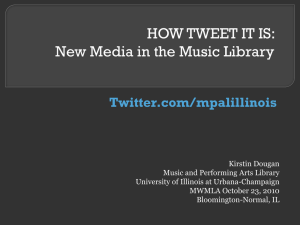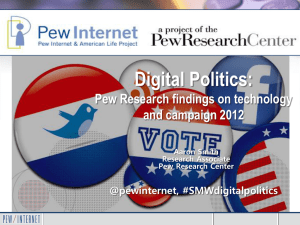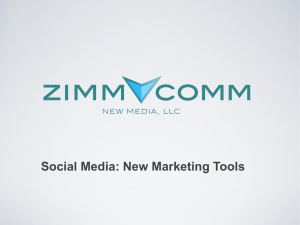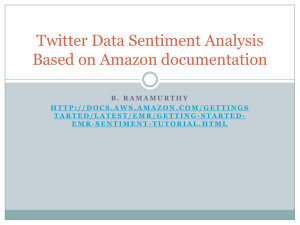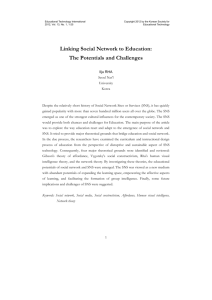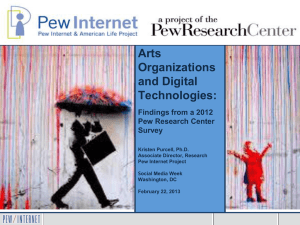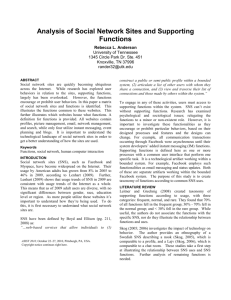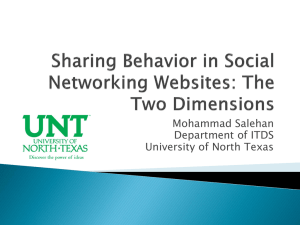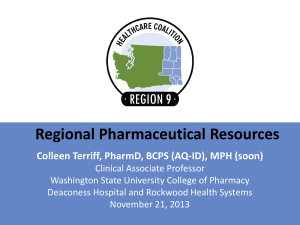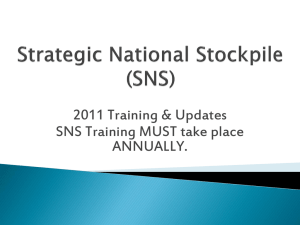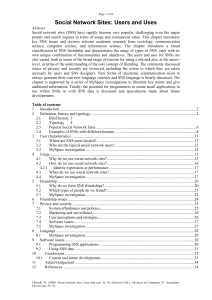Digital Differences Data and trends
advertisement
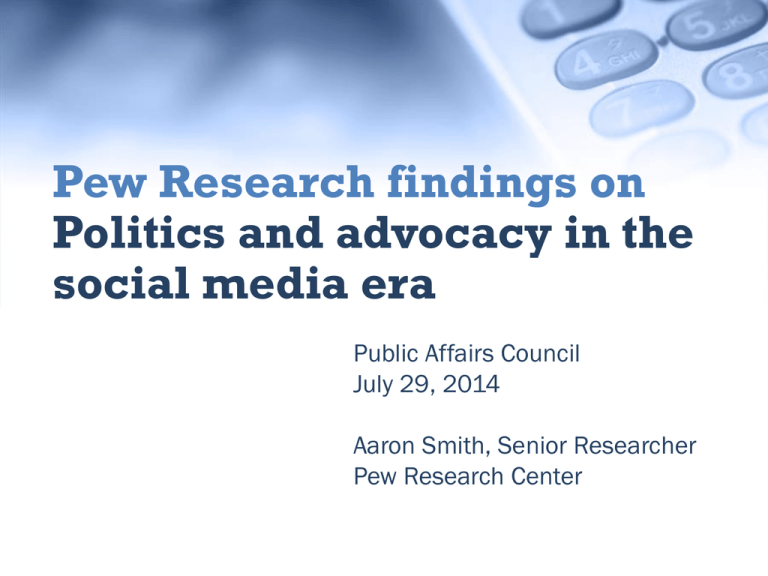
Pew Research findings on Politics and advocacy in the social media era Public Affairs Council July 29, 2014 Aaron Smith, Senior Researcher Pew Research Center About Pew Research Center’s Internet Project • Part of the Pew Research Center, a non-partisan “fact tank” in Washington, DC • Study how people use digital technologies • We are researchers, not practitioners or advocates – We do not promote specific technologies or make policy recommendations • Data for this talk is from nationally representative surveys (both telephone and online) of U.S. adults • All data and reports are available at www.pewresearch.org How times have changed…for all of us Our outreach strategy in 2000 Our outreach strategy in 2014 Surveys of tech use in 2000 Almost everyone had landlines, 28% response rate Less than half the country went online, not much social media, no smartphones Vast majority of online access took place in a stationary environment “Going online” was typically a discrete activity oriented around a specific task Pretty easy to ask people about their device usage and online behaviors Surveys of tech use in 2014 41% of households are wireless-only, 9% RR Access is increasingly on-the-go. People engage with a host of devices, platforms, and news sources, all throughout the day Things like “going online”, “getting news”, or “talking politics” are continuous activities Hard for ordinary users to recall and discuss specific actions they might have taken Untangling the “impact” of any single device, article, event, tweet, etc. is really hard Which is to say, we’re all working our way through this new world as we go Trends and demographics in tech use A few basics % of U.S. adults who… 90% -- cell phone (53% in 2000) 87% -- use the internet (46% in 2000) 70% -- broadband @ home (3% in 2000) 68% -- mobile internet user 58% -- smartphone (35% in 2011) SNS trend over time % of internet users who use social networking sites 100% 80% 67% 73% 61% 60% 40% 37% 20% 8% 0% Winter 2005 Fall 2008 Fall 2010 Fall 2012 Fall 2013 Usage by older adults is growing fast, but younger users still lead the way 100% 90% 78% 80% 65% 60% 46% 40% 20% 0% 18-29 30-49 50-64 65+ Facebook is by far the dominant platform in overall numbers But other sites have comparable levels of user engagement % of users who check in daily: 63% -- Facebook 57% -- Instagram 46% -- Twitter 23% -- Pinterest 13% -- LinkedIn And each site has its own unique user mix Facebook – Looks like the internet user population, just younger Twitter – Young, ethnically diverse, mobile-centric Instagram – See Twitter Pinterest – Lots of women LinkedIn – Middle-aged professionals Political characteristics of SNS use Not too many partisan differences re: FB use Dems are more likely than Reps to use Twitter (19% vs. 10%) Liberal Ds are 2x as likely to use Twitter as Conservative Rs (22% vs. 11%) Liberals/Ds also more likely to regularly get political news on FB and Twitter Democrats a bit more likely to say social media is important to their political activity % who say SNS very/somewhat important for: Keeping up w/ political activity – D 48%, R 34% Recruiting people to get involved – D 35%, R 25% Finding others w/ my views – D 34%, R 23% Debating political issues – D 32%, R 24% Social media as a news platform The size of the social media news population Source: Pew Research Center, Facebook News Survey, Aug 21-Sept 3, 2013 Facebook and news Reasons people use Facebook: 68% -- See what friends/family are up to 62% -- See photos/videos 38% -- Chat or message 17% -- Post personal updates 16% -- Get news 14% -- Play games Twitter and news Twitter news consumers are… 1) Mobile-centric 2) Young 3) Ethnically diverse 4) Use Twitter to make sense of breaking events “Twitter opinion” is not always the same as public opinion (Ron Paul edition) “Twitter opinion” is not always the same as public opinion (gay marriage edition) Social media as a platform for political engagement Ways we measure political engagement by social media users 38% -- Like or promote political content 35% -- Encourage others to vote 34% -- Post own comments on politics 33% -- Repost others’ political content 31% -- Encourage others to take action 28% -- Post links to political articles 21% -- Belong to a political group 20% -- Follow candidates/elected officials More social media users are engaging in political activities there 60% 40% 28% 21% 20% 20% 11% 13% 12% 0% Post political news Friend or follow political figures 2008 2012 Start or join political group SNS discussions can spur more info seeking or involvement 43% of SNS users have decided to learn more about a political or social issue because of something they read on social media 18% of SNS users have decided to take action involving a political or social issue because of something they read on social media At the same time, most “calls to action” occur outside of social media And half the public “never” discusses politics online As with news, social networks are not an overtly “political” space for most… How much of what you / your friends post is related to politics, elections, or political issues: 11 None Keeping up w/ political news: 45% 50 68 Some / Just a little Finding others who share your views about political issues: 35% Debating or discussion political issues w/ others: 33% 44 19 All / Almost all 6 What you post % who say social networking sites are “very” or “somewhat” important” to: What your friends post Recruiting others to get involved with political issues: 32% And they can be a source of frustration and annoyance when things turns political Polarization is the dominant feature of political life today Democrats and Republicans have been growing apart in their beliefs and attitudes And also growing apart in their personal opinions and preferences People want to live with others who share their political views And even see the other side as a threat to the very future of America as we know it How this plays out in the social media environment The major “social media and politics” dividing line vs. #1: People want to “live” with likeminded people on social media #2: People on the “edges” are more likely to be politically active on social media % of SNS users who are politically active on social media 100% 82% 80% 73% 60% 60% 56% 40% 20% 0% Conservative Rep Mod/Lib Rep Mod/Cons Dem Liberal Dem #3: They’re also more likely to say that SNS convos have inspired them to take action % of SNS users who have taken action on a political issue based on what they read on SNS 60% 40% 27% 20% 21% 11% 10% Mod/Lib Rep Mod/Cons Dem 0% Conservative Rep Liberal Dem #4: Social media activism and real-world activism often overlap So what can we take away from all this? #1: Are you trying to activate the “poles”? They like you and/or your cause (or possibly hate you and think you’re destroying America) They are probably already talking about you (and if they aren’t already, they’d probably like to) Social media offers a way to find, identify, and reach your “super fans” They want to be part of the team and convert their friends—if you let them #2: Or are you trying to rouse the middle? Don’t engage consistently with politics They probably don’t really know or care very much about your particular issue Their tolerance threshold is probably fairly low… But they can be encouraged to learn/act/change! Sometimes that happens because of big events that grab their attention—but many times it’s at the behest of someone from the previous group #3: Think about your audience/community People use digital platforms for two reasons: 1) Their friends are there 2) The content they like is there When planning an outreach strategy, consider: 1) Where does my audience “live”? 2) Is my content relevant for this platform? Aaron Smith Senior Researcher Pew Research Center’s Internet Project asmith@pewresearch.org @aaron_w_smith @pewinternet @pewresearch


